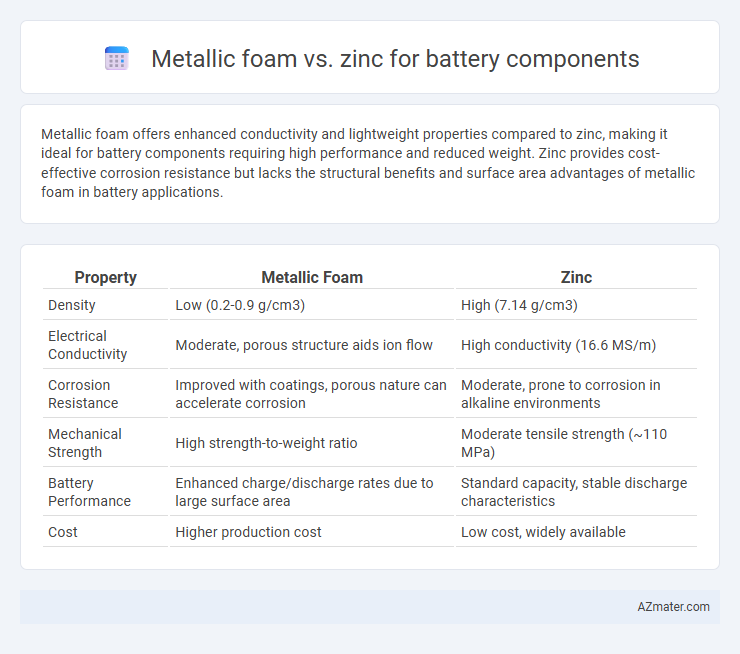Metallic foam offers enhanced conductivity and lightweight properties compared to zinc, making it ideal for battery components requiring high performance and reduced weight. Zinc provides cost-effective corrosion resistance but lacks the structural benefits and surface area advantages of metallic foam in battery applications.
Table of Comparison
| Property | Metallic Foam | Zinc |
|---|---|---|
| Density | Low (0.2-0.9 g/cm3) | High (7.14 g/cm3) |
| Electrical Conductivity | Moderate, porous structure aids ion flow | High conductivity (16.6 MS/m) |
| Corrosion Resistance | Improved with coatings, porous nature can accelerate corrosion | Moderate, prone to corrosion in alkaline environments |
| Mechanical Strength | High strength-to-weight ratio | Moderate tensile strength (~110 MPa) |
| Battery Performance | Enhanced charge/discharge rates due to large surface area | Standard capacity, stable discharge characteristics |
| Cost | Higher production cost | Low cost, widely available |
Introduction to Battery Component Materials
Metallic foam offers a high surface area and lightweight structure, enhancing electrode conductivity and electrolyte diffusion in battery components compared to traditional zinc. Zinc provides cost-effective, stable electrochemical properties with high energy density but suffers from dendrite formation and limited cycle life. Advanced metallic foam materials are being explored to overcome zinc's limitations by improving durability and power performance in battery electrodes.
Overview of Metallic Foam in Batteries
Metallic foam in batteries offers a high surface area-to-volume ratio that significantly enhances electrode-electrolyte interaction, improving charge transfer efficiency and battery performance. Its porous structure enables better accommodation of volume changes during charge-discharge cycles, reducing mechanical stress and extending battery lifespan compared to traditional zinc electrodes. Commonly made from materials like nickel or copper, metallic foam serves as a lightweight, conductive scaffold that supports active materials and facilitates faster ion transport in advanced energy storage systems.
Zinc as a Traditional Battery Material
Zinc has been a traditional battery material due to its high energy density, low cost, and environmental friendliness, making it ideal for alkaline and zinc-air batteries. While metallic foam structures offer enhanced surface area and improved electrode kinetics, zinc's well-established electrochemical performance and widespread availability continue to dominate battery component applications. Research into zinc-based materials focuses on addressing dendrite formation and improving cycle life to maintain its competitive edge over emerging alternatives like metallic foam.
Structural Properties: Metallic Foam vs Zinc
Metallic foam exhibits exceptional structural properties, including high strength-to-weight ratios and enhanced energy absorption, making it a promising material for battery components requiring lightweight and durable support. Zinc, while offering moderate mechanical strength, provides superior corrosion resistance and electrochemical stability but lacks the porous, impact-resistant architecture characteristic of metallic foams. The choice between metallic foam and zinc hinges on balancing mechanical robustness and electrochemical performance in battery design.
Electrical Conductivity Comparison
Metallic foam exhibits a unique porous structure that enhances surface area while maintaining moderate electrical conductivity, making it suitable for battery electrodes requiring efficient electron transfer and ion transport. Zinc, a commonly used anode material, offers higher intrinsic electrical conductivity (16.6x10^6 S/m) compared to many metallic foams but lacks the structural advantages that foam materials provide for electrolyte interaction. The choice between metallic foam and zinc for battery components fundamentally depends on balancing conductivity requirements with mechanical and electrochemical performance for optimal battery efficiency.
Electrochemical Performance
Metallic foam offers a high surface area and excellent electrical conductivity, significantly enhancing the electrochemical performance of battery components by improving charge transfer and ion diffusion. Zinc, widely used as an anode material, provides high energy density and stability but suffers from dendrite formation and limited conductivity in its bulk form. Incorporating metallic foam structures with zinc can mitigate these issues by facilitating uniform zinc deposition and reducing polarization, thereby extending battery lifespan and efficiency.
Mechanical Strength and Durability
Metallic foam exhibits superior mechanical strength and enhanced durability compared to zinc when used as a battery component, providing excellent impact resistance and weight reduction. Its porous structure allows for better energy absorption and long-term structural integrity under cyclic loading conditions. Zinc, while cost-effective and chemically stable, often falls short in mechanical robustness and is more prone to degradation during repeated charge-discharge cycles.
Cost-Effectiveness and Scalability
Metallic foam offers superior cost-effectiveness and scalability compared to zinc for battery components due to its lightweight structure and lower material consumption, reducing overall manufacturing expenses. Zinc, while abundant and inexpensive, often incurs higher processing costs and faces challenges in scalable production for consistent foam quality. The porous nature of metallic foam enhances electrochemical performance and allows for easier adaptation in large-scale battery manufacturing, making it a more economically viable option.
Sustainability and Environmental Impact
Metallic foams offer enhanced sustainability in battery components due to their lightweight structure, reduced material usage, and improved recyclability compared to traditional zinc. Zinc, while abundant and non-toxic, faces challenges related to resource depletion and environmental impact from mining and refining processes. Incorporating metallic foam materials can significantly lower the carbon footprint and improve the lifecycle sustainability of battery technology.
Future Trends in Battery Material Innovation
Metallic foam offers superior surface area and enhanced conductivity, making it a promising material for next-generation battery electrodes compared to traditional zinc. Zinc remains a cost-effective and environmentally friendly option, but innovations in metallic foam composites are driving improvements in energy density and charge-discharge rates. Future trends emphasize hybrid materials combining metallic foam's structural benefits with zinc's electrochemical properties to achieve higher performance and longer battery life.

Infographic: Metallic foam vs Zinc for Battery component
 azmater.com
azmater.com